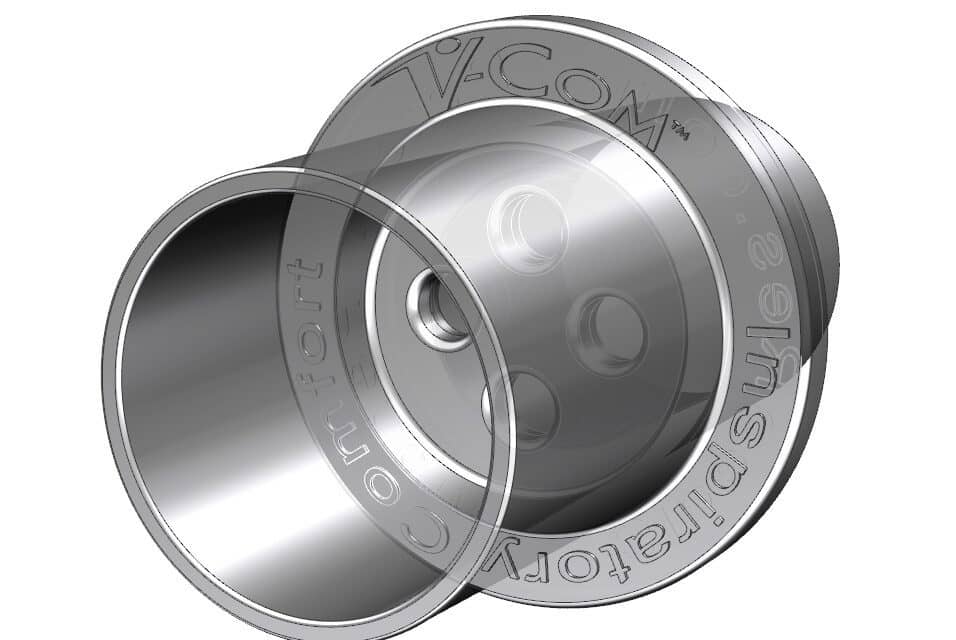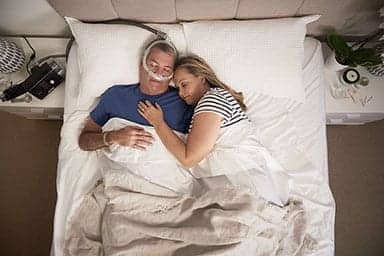At SLEEP 2022, SleepRes LLC introduced the V-Com, a CPAP accessory that the company describes as “training wheels for CPAP.” It softens peak inspiratory flow of positive airway pressure (PAP) devices.
V-Com is added between the CPAP mask and the CPAP hose and is engineered to reduce inspiratory pressure and flow to provide comfort with minimal to no reduction in expiratory pressure (EPAP). After weeks or months when the patient can easily tolerate the peak flow and inspiratory pressure of PAP therapy, the V-Com can be removed from the circuit.
“I got to try a prototype of the V-Com several months ago, and the comfort was dramatic, especially at higher pressures,” says John Cason, regional senior vice-president of Adapt Health, in a release. “We have been waiting for the launch this week at APSS because we believe [the V-Com] is going to improve adherence, and at Adapt that is our goal.”
The V-Com is for new (or struggling) patients on CPAP and bi-level PAP for noninvasive ventilation (NIV). Like training wheels on a bicycle, V-Com helps patients adjust easier and faster to CPAP, according to SleepRes.
“Physicians, respiratory therapists, and sleep techs are loving our training wheels analogy,” says Kami Harold, vice-president of sales for SleepRes, in a release. “Not every child needs training wheels, but training wheels makes learning to ride a bike faster and safer for all kids. It is the same with V-Com and CPAP.” V-Com is not to be confused with expiratory reduction algorithms that are native to some CPAP devices and reduce EPAP. V-Com reduces inspiratory pressure for comfort but maintains EPAP for therapy and safety from rebreathing CO2.
“So far over 90% of new CPAP patients who have tried the V-Com felt the difference and believe the V-Com will help them adjust to CPAP faster,” says Harold. “We tell sleep clinicians that 15 seconds of experiencing the V-Com yourself is better than 15 minutes of us explaining the physics and engineering of the device.”
“Clinicians commonly ask, ‘Can’t I just turn the pressure down?’ The answer is clearly no,” says Allen Manus, RRT with the Veterans’ Administration, in a release. “Turning the pressure down lowers EPAP, which increases respiratory events and the risk of rebreathing [CO2]. Plus, turning down the pressure requires running down a doctor to get an order and then later running them down again to change the order back. V-Com is not only better for my patients but better for our staff.”
Carmen Keasling, RPSGT, says in a release, “We are finding that during CPAP titrations that the V-Com can resolve a patient’s mouth coming open and eliminate the need for a chinstrap. [V-Com] is not only better for the patient; it makes it easier on our sleep techs.”
In SleepRes’ testing, the V-Com had minimal effect on auto-PAP and residual index algorithms. Testing results are available on the frequently asked questions section of SleepRes’ website. “You can find the results of our testing with various algorithms and testing with NIV and oxygen therapy,” says Harold. “And we have some preliminary data suggesting the V-Com may reduce treatment-emergent central sleep apnea.”
If you like the current article, check out this one
The Fallacy of Full-Face CPAP Masks
V-Com has also been shown to reduce the noise of the CPAP device by up to 15 decibels.
“It’s a total gamechanger,” says Tod York, senior vice-president of React Health (formerly 3B Medical), in a release. “The comfort [V-Com] provides is remarkable, but I also noticed the decrease in sound coming from the [CPAP] device. Noise is a big issue to new users, and V-Com addressed the noise issue as well.”
Craig Salazar, president of SleepRes, says in a release, “We expect the retail price to be $25-$30. After having to spend more than $1,000 to start CPAP, we want this increased opportunity for success to be as inexpensive as possible.”
Jason Shiflet, CEO of Home Medical Products Inc, says in a release, “We may just buy them and give them to all our patients. Yes, increased adherence means increased revenue, but when you consider the decreased phone calls, complaints, and mask exchanges, along with happier patients, it just seems obvious.”
SleepRes was founded by William H. Noah MD, a pulmonary, critical care, and sleep medicine physician, to re-evaluate decades of PAP therapy and delivery methods. V-Com is the first product in a series of solutions to be released by SleepRes.
Eugene Scarberry, a retired senior staff engineer at Philips Respironics and expert on CPAP engineering and circuits, notes that comfort advances have come mainly from engineers at the manufacturers. Scarberry says, “At the end of the day it is all about adherence and the V-Com is a whole new approach to increase early adherence that us manufacturers never thought of.
“The V-Com came from a physician determined to get better adherence, who figured out the physiology and then worked hard to master the engineering. I am very proud of his efforts which should greatly help his and his peers’ patients.”
“I believe Dr. [William] Noah has created something truly unique,” says Robert Miller, RPSGT, RST, vice president of Apria Healthcare, in a release. “He may just make the industry reconsider the PAP therapy circuit, especially for patients on higher pressures.”





